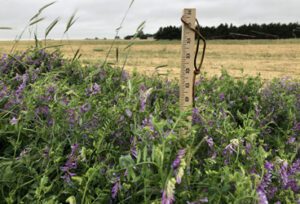
The two most common questions we receive when fertilizer prices go up are “Have you heard what they predict nitrogen fertilizer will cost next year?” and “What can I plant to reduce my need for nitrogen fertilizer?” Both are legitimate and timely questions.
At one time, all of our crop nitrogen needs were supplied by biological fixation from legumes or cycling biological fertility (manure and other residues). More than a hundred years ago, the German chemists Fritz Haber and Carl Bosch developed a process to create ammonia from atmospheric air (which is 78% N) and methane. Originally, this process was primarily used to produce explosive materials for use in the two World Wars. After the end of WW II, the production of anhydrous ammonia was rechanneled from making bombs to making fertilizer for growing crops. This nitrogen revolution changed how we do things in agriculture and we have largely lost the knowledge of how to farm without synthetic fertilizers.
Given the growing need to produce food, feed, fuel and fiber, many people rightly wonder if we can generate enough nitrogen from biological means to eliminate or at least reduce our synthetic nitrogen while remaining profitable. Luckily, the answer is a resounding “YES”, but it likely will require changes in the way we grow crops to accommodate these biological processes. Since understanding the mechanisms behind the process allows the user to intelligently manage the system, let’s review or learn a few things about biological nitrogen fixation. A deeper dive into the scientific aspect of this process can be found in Nitrogen, the Double-Edged Sword article found on pages 24-25
The amount of nitrogen that can be produced by a legume cover crop is directly related to the volume of biomass produced. This number will depend on many factors including moisture, temperature, soil compaction, length of growing season, mineral nutrient availability, and biological activity. While it is impossible to predict exactly how much nitrogen will be produced, some general rules can be applied.

Fall planted hairy vetch and cereal rye with more than 4 tons per acre biomass and 180 lbs. of nitrogen.
Photo By: Davis Behle
Summer annual legumes (soybeans, cowpeas, mung beans, sunn hemp) generally fix more nitrogen per day of growth than winter annual legumes (peas, lentils, vetch, clovers), because there is more sunlight and more favorable temperatures. However, winter annual legumes can have more days of active growth due to their ability to grow in the fall, survive the winter and continue to grow in the spring. In general, legume biomass runs about 3% nitrogen, thus, a ton will contain about 60# of nitrogen. Under good conditions (temperature and moisture), warm season legumes can produce up to 70# of biomass per day, or about a ton per month.

Photo by: Green Cover
Obviously, then a cover crop of summer annual legumes will fix more nitrogen the longer it grows, but 150-180 # is still achievable from a July planting after wheat harvest. Winter annual legumes, if planted in fall, usually make most of their growth (and thus nitrogen) in spring, and the longer they are allowed to grow in spring, the more biomass and more nitrogen they can produce. Our Green Cover demonstration plots have show that more than 70% of the nitrogen fixed by winter peas or hairy vetch will occur during the month of May. In Nebraska, nitrogen amounts of 180 – 220# are possible when these covers are allowed to grow until late May. The amount of this nitrogen from the biomass of a plant that we can make available to the next crop will depend on many factors including C:N ratio of the cover crop, amount of time from cover crop termination until next crop need, temperature and moisture. A general rule of thumb is that 2/3 of the N from a low carbon (C:N less than 25) summer cover will be available for next year’s corn crop and ½ of the N from a low carbon winter cover will be available for the following crop. The remainder of the nitrogen for these cover crops will be available for future crops.
To utilize nitrogen fixing cover crops in a cropping system, it may be necessary to modify your rotation. Consider the ubiquitous corn-soybean rotation. Everyone is desperately seeking a legume that can be planted after soybean harvest in the fall, which can be terminated for in early April for corn planting and produce enough nitrogen to support 240 bushel corn yields. This just is not feasible, but with a few changes, it is possible to greatly reduce the need for purchased nitrogen in a corn-soybean rotation.
- Plant shorter season beans to get the fall cover established sooner.
- Plant shorter season corn so it can be planted a little later in the spring and allow the cool season covers to grow longer.
- Add a summer harvested crop to the rotation (small grain or peas) which allows a summer cover to be planted to produce nitrogen ahead of corn. Cool season legumes can still be planted right before frost to “double down” on nitrogen production ahead of a corn crop.
- Lengthen the rotation a year by incorporating a full year of grazed cover crops, as described in the article “Corn, Beans and Cattle” on pages 36-37
- Insert a few years of a pastured sod crop such as an alfalfa & orchardgrass mixture into the rotation. Research and practical experience alike demonstrate that corn following a terminated pasture sod with appreciable alfalfa content will produce maximum yields without need for supplemental nitrogen fertility.
- A highly experimental option is the use of perennial legumes as a “living mulch” system, in which corn is planted into suppressed strips of alfalfa or white clover. The legume stands regenerates year after year, providing a constant source of nitrogen. This is a strategy that requires high levels of management but pays off big when it works well.
- Utilize free-living nitrogen fixing bacteria that can live in the rhizosphere of plants like corn or sorghum. Our Bi-Azo inoculant features two such nitrogen fixing bacteria, Azotobacter and Azospirillum. This organisms will not produce large amounts of nitrogen (30-50# per acre), but the cost is low (less than $4 per acre) and it does not take much extra N to pay for it. It can be put on a cover crop preceding corn or directly on the seed corn prior to planting or both. If you are deficient in nitrogen, each pound of extra N might just gain you an extra bushel of yield.

Azotobacter and Azospirillum are free-living organisms that can fix atmospheric nitrogen into plant available forms.
This article first appeared in the 8th Edition of Green Cover's Soil Health Resource Guide.
Also check out the 10th edition, our latest Soil Health Resource Guide, over 90 pages packed with scientific articles and fascinating stories from soil health experts, researchers, farmers, innovators, and more! All as our complimentary gift to you, a fellow soil health enthusiast!